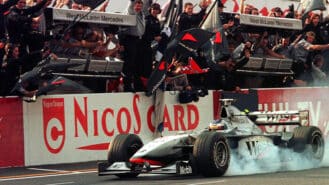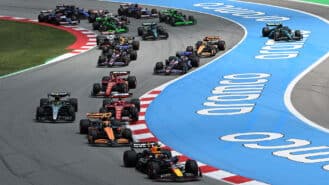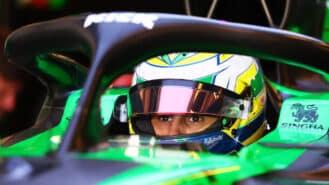By Lee McKenzie
F1 is a sport used to making the news as much for its off-track dramas as the on-track excitement and before the weekend had even started, the stories were spilling out of Melbourne.

We knew that, sadly, Fernando Alonso wouldn’t be racing after sustaining a concussion in an accident during pre-season testing in Barcelona – that in itself was a dramatic and worrying enough start to proceedings. Add to the mix the against-the-odds arrival of Manor and a courtroom battle between Sauber and Giedo van der Garde and the soap opera had started earlier than advertised.

Twenty days before free practice, Marussia’s assets were still up for sale. Crucial car-running information had been wiped from hard drives and parts of the car packed away ready for a sort of high-end Bargain Hunt. It is little wonder that the team couldn’t get the cars running on the weekend. Now, though, the FIA are looking into whether there was ever any intent to run the cars this weekend or if the team was purely garage squatting in order to receive the prize money from last season. That one will rumble on, but let’s hope that we see the cars on track in Malaysia.
Another main talking point was the court battle between Giedo van der Garde and Sauber. We know that courts around the world ruled in favour of van der Garde and that he did have a valid contract to race in 2015. It’s what was decided when the two settled out of court which is not clear yet.
The situation was not handled well. Most media have an understanding of law and the courtrooms, having served their time as cub reporters before specialising or working their way up the ranks. We all knew what could and couldn’t be said, but there wasn’t even any information forthcoming when trying to understand why the two drivers were sitting in the cars in almost empty garages during FP1 or why van der Garde had been wearing Marcus Ericcson’s race suit before being escorted out of the paddock when he didn’t have a Super Licence or pass on Friday morning! That evening in the team bosses’ press conference the normally unflappable Monisha Kaltenborn, also a very experienced lawyer, looked stressed as she delivered over and over again her most-used phrase of the weekend: “no comment”.

Thinking that by Saturday afternoon the race weekend might be on the straight and narrow was foolish. There was to be no revelling in the on-track action as we all wondered about Williams and, more importantly, its driver. Valtteri Bottas injured his back during qualifying and as a precaution went to hospital for an MRI scan. He stayed in overnight but felt by the Sunday morning, after intense physio, that he was fit to race. Before the race he met the requirements of the FIA extraction test – where they practice getting out of a car within five seconds in case of an emergency – but the FIA still deemed him unfit. Bottas is a tough cookie and spectating is not his thing. The FIA must have had good reason to say no, but Bottas will be looking to retrieve some missed points upon his return in Sepang.
So, by the time the pitlane opened we were three cars down. Seventeen headed out onto the grid, but even that wasn’t to be: first out on the recce lap was Kevin Magnussen, who was looking forward, even in a beleaguered car, to his first race after being sidelined by McLaren. Red Bull’s woes only deepened as it watched Daniil Kvyat stop on the way to the grid after a gearbox problem.
After a weekend of off-track issues, a great race would have been the perfect tonic. Sadly we didn’t get that, but if we look at the positives then we did see a faultless performance from Lewis Hamilton, signs of a rejuvenated Ferrari with Sebastian Vettel and three rookies stepping up to the mark.

On the Sunday morning I was driven into the track by Carlos Sainz Jr for a feature on the BBC’s Malaysian GP coverage. I also spent a bit of time with Max Verstappen that morning too. I just couldn’t believe how relaxed they were. Both are overly mature for their respective ages; they were happy, excited, but in total control. Whether growing up in motor sport families means that neither get phased easily or if being part of a successful young driver programme means you are conditioned to pressure and progress I am not sure, but even on the grid, giving mature and confident interviews, we were seeing the arrival of two new stars.
The other rookie was Felipe Nasr, someone who I have known since his days in British F3. To see him handle not only the pressures of the potential Sauber musical chairs, but a great qualifying and strong race, was a relief and a pleasure. He was so emotional after the race and no wonder – his performance is the best debut in F1 for any Brazilian driver. It was also good to see Sauber getting its act together, on track at least. Don’t forget that the team didn’t score a single point last season.
While the more experienced drivers are recuperating and the big teams continue to struggle, these next races are the time for the rookies and smaller teams to harvest the points and capitalise on others’ misfortunes.
Next up is the heat and humidity of Malaysia. It’s proved a pressure cooker before but it would be great if the pressure was on track and not off it. At least we can hope for 20 cars on the grid!








